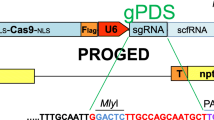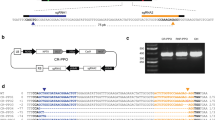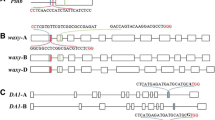Abstract
CRISPR/Cas9 has emerged as a simple, yet efficient gene editing tool to generate targeted mutations in desired genes in crops plants. Agrobacterium tumefaciens, a reliable and inexpensive DNA-delivery mechanism into plant cells, has been used for the generation of CRISPR/Cas9-mediated mutations in crop plants, including potato. However, little information is available as to the progression of gene knockout during various stages of culture following the introduction of CRISPR components in this species. In the current study, the green fluorescent protein (gfp) transgene was first introduced in the genome of a potato variety, Yukon Gold. Two GFP-expressing lines, one with a single gfp copy integrated and another with four gfp copies integrated, were subjected to CRISPR/Cas9-mediated mutations in the transgene(s) using three different gRNAs. Disappearance of GFP fluorescence was monitored during the entire culture/regeneration process. Although all three gRNAs successfully knocked out the transgene(s), their efficiencies differed greatly and did not completely match the predicted scores by some guide RNA prediction tools. The nature of mutations in various knockout events was analyzed. Several lines containing four gfp-copies showed four different types of mutations. These findings suggest that it is possible to target all four alleles of a desired native gene in the tetraploid potato.
Key message
Potato lines, with a single or four copies of the gfp transgene integrated, were subjected to CRISPR/Cas9-mediated mutations. The results indicated that it should be possible to target and knock out multiple copies of a native gene in the tetraploid genotypes of this crop.








Similar content being viewed by others
Data availability
The datasets generated during and/or analyzed during the current study are available from the corresponding author on a reasonable request.
References
Baltes NJ, Gil-Humanes J, Cermak T, Atkins PA, Voytas DF (2014) DNA replicons for plant genome engineering. Plant Cell 26:151–163. https://doi.org/10.1105/tpc.113.119792
Baysal C, Bortesi L, Zhu C, Farré G, Schillberg S, Christou P (2016) CRISPR/Cas9 activity in the rice OsBEIIb gene does not induce off-target effects in the closely related paralog OsBEIIa. Mol Breed 36:108–119. https://doi.org/10.1007/s11032-016-0533-4
Bolger AM, Lohse M, Usadel B (2014) Trimmomatic: a flexible trimmer for Illumina sequence data. Bioinform (oxford, England) 30:2114–2120. https://doi.org/10.1093/bioinformatics/btu170
Bruce MA, Shoup Rupp JL (2019) Agrobacterium-mediated transformation of Solanum tuberosum L., potato. In: Kumar S, Barone P, Smith M (eds) Transgenic Plants: Methods and Protocols 1864. Springer, New York, pp 203–223
Camire ME, Kubow S, Donnelly DJ (2009) Potatoes and human health. Crit Rev Food Sci Nutr 49:823–840. https://doi.org/10.1080/10408390903041996
Campos H, Ortiz O (2020) The potato crop, its agricultural nutritional and social contribution to humankind. Springer, Lima
Cermak T, Starker CG, Voytas DF (2015) Efficient Design and Assembly of Custom TALENs Using the Golden Gate Platform. Chromosomal Mutagenesis. Springer Science, New York
Chetty VJ, Narváez-Vásquez J, Orozco-Cárdenas ML (2015) Potato (Solanum tuberosum L.). In: Wang K (ed) Agrobacterium Protocols. Springer, New York
Cong L, Ran FA, Cox D, Lin S, Barretto R, Habib N, Hsu PD, Wu X, Jiang W, Marraffini LA, Zhang F (2013) Multiplex genome engineering using CRISPR/Cas systems. Science 339:819–823. https://doi.org/10.1126/science.1231143
Corish P, Tyler-Smith C (1999) Attenuation of greenfluorescent protein half-life in mammalian cells. Protein Eng 12:1035–1040. https://doi.org/10.1093/protein/12.12.1035
De Block M (1988) Genotype-independent leaf disc transformation of potato (Solanum tuberosum) using Agrobacterium tumefaciens. Theor Appl Genet 76:767–774. https://doi.org/10.1007/BF00303524
Devaux A, Goffart J-P, Petsakos A, Kromann P, Gatto M, Okello J, Suarez V, Hareau G (2020) Global Food Security, Contributions from Sustainable Potato Agri-Food Systems. In: Campos H, Ortiz O (eds) The Potato Crop. Springer, Cham
Doudna JA, Charpentier E (2014) The new frontier of genome engineering with CRISPR-Cas9. Science 346:1258096. https://doi.org/10.1126/science.1258096
Enciso-Rodriguez F, Manrique-Carpintero NC, Nadakuduti SS, Buell CR, Zarka D, Douches D (2019) Overcoming self-incompatibility in diploid potato using CRISPR-Cas9. Front Plant Sci 10:376. https://doi.org/10.3389/fpls.2019.00376
FAOSTAT (2019) Crops and livestock products. https://www.fao.org/faostat/en/#data/QCL. Accessed 31 January 2022
Gilbert LA, Larson MH, Morsut L, Liu Z, Brar GA, Torres SE, Stern-Ginossar N, Brandman O, Whitehead EH, Doudna JA, Lim WA, Weissman JS, Qi LS (2013) CRISPR-mediated modular RNA-guided regulation of transcription in eukaryotes. Cell 154:442–451. https://doi.org/10.1016/j.cell.2013.06.044
González MN, Massa GA, Andersson M, Turesson H, Olsson N, Fält A-S, Storani L, Décima Oneto CA, Hofvander P, Feingold SE (2020) Reduced enzymatic browning in potato tubers by specific editing of a polyphenol oxidase gene via ribonucleoprotein complexes delivery of the CRISPR/Cas9 system. Front Plant Sci 10:1649. https://doi.org/10.3389/fpls.2019.01649
Haseloff J, Siemering KR, Prasher DC, Hodge S (1997) Removal of a cryptic intron and subcellular localization of green fluorescent protein are required to mark transgenic Arabidopsis plants brightly. PNAS 94:2122–2127. https://doi.org/10.1073/pnas.94.6.2122
Haverkort AJ, De Ruijter FJ, Van Evert FK, Conijn JG, Rutgers B (2013) Worldwide sustainability hotspots in potato cultivation. 1 identification and mapping. Potato Res 56:343–353. https://doi.org/10.1007/s11540-013-9247-8
Janga MR, Campbell LM, Rathore KS (2017) CRISPR/Cas9-mediated targeted mutagenesis in upland cotton (Gossypium hirsutum L.). Plant Mol Biol 94:349–360. https://doi.org/10.1007/s11103-017-0599-3
Jiang F, Doudna JA (2017) CRISPR–Cas9 structures and mechanisms. Annu Rev Biophys 46:505–529. https://doi.org/10.1146/annurev-biophys-062215-010822
Liang G, Zhang H, Lou D, Yu D (2016) Selection of highly efficient sgRNAs for CRISPR/Cas9-based plant genome editing. Sci Rep 6:21451. https://doi.org/10.1038/srep21451
Liu J, Nannas NJ, Fu FF, Shi J, Aspinwall B, Parrott WA, Dawe RK (2019) Genome-scale sequence disruption following biolistic transformation in rice and maize. Plant Cell 31:368–383. https://doi.org/10.1105/tpc.18.00613
Ma X, Zhang Q, Zhu Q, Liu W, Chen Y, Qiu R, Wang B, Yang Z, Li H, Xie Y, Shen R, Chen S, Wang Z, Chen Y, Guo J, Chen L, Zhao X, Dong Z, Liu Y (2015) A robust CRISPR/Cas9 system for convenient, high-efficiency multiplex genome editing in monocot and dicot plants. Mol Plant 8:1274–1284. https://doi.org/10.1016/j.molp.2015.04.007
Magoč T, Salzberg SL (2011) FLASH: fast length adjustment of short reads to improve genome assemblies. Bioinform (oxford, England) 27:2957–2963. https://doi.org/10.1093/bioinformatics/btr507
Ooms G, Bossen ME, Burrell MM, Karp A (1986) Genetic manipulation in potato with Agrobacterium rhizogenes. Potato Res 29:367–379. https://doi.org/10.1007/BF02359965
Pan C, Ye L, Qin L, Liu X, He Y, Wang J, Chen L, Lu G (2016) CRISPR/Cas9-mediated efficient and heritable targeted mutagenesis in tomato plants in the first and later generations. Sci Rep 6:24765. https://doi.org/10.1038/srep24765
Pinello L, Canver MC, Hoban MD, Orkin SH, Kohn DB, Bauer DE, Yuan G (2016) Analyzing CRISPR genome-editing experiments with CRISPResso. Nat Biotechnol 34:695–697. https://doi.org/10.1038/nbt.3583
Puchta H (2005) The repair of double-strand breaks in plants: mechanisms and consequences for genome evolution. J Exp Bot 56:1–14. https://doi.org/10.1093/jxb/eri025
Qi Y (2019) Plant genome editing with CRISPR systems. Humana Press, New York
Schaart JG, Van De Wiel CCM, Smulders MJM (2021) Genome editing of polyploid crops: prospects, achievements and bottlenecks. Transgenic Res 30:337–351. https://doi.org/10.1007/s11248-021-00251-0
Sheerman S, Bevan MW (1988) A rapid transformation method for Solanum tuberosum using binary Agrobacterium tumefaciens vectors. Plant Cell Rep 7:13–16. https://doi.org/10.1007/BF00272967
Shepard JF, Bidney D, Shahin E (1980) Potato protoplasts in crop improvement. Science 208:17–24. https://doi.org/10.1126/science.208.4439.17
Siemering KR, Golbik R, Sever R, Haseloff J (1996) Mutations that suppress the thermosensitivity of green fluorescent protein. Curr Biol 6:1653–1663. https://doi.org/10.1016/S0960-9822(02)70789-6
Stiekema WJ, Heidekamp F, Louwerse JD, Verhoeven HA, Dijkhuis P (1988) Introduction of foreign genes into potato cultivars Bintje and Désirée using an Agrobacterium tumefaciens binary vector. Plant Cell Rep 7:47–50. https://doi.org/10.1007/BF00272976
Stokstad E (2019) The new potato. Science 363:574–577. https://doi.org/10.1126/science.363.6427.574
Sunilkumar G, Mohr L, Lopata-Finch E, Emani C, Rathore KS (2002) Developmental and tissue-specific expression of CaMV 35S promoter in cotton as revealed by GFP. Plant Mol Biol 50:463–479. https://doi.org/10.1023/A:1019832123444
Toinga-Villafuerte S, Vales MI, Awika JM, Rathore KS (2022) CRISPR/Cas9-mediated mutagenesis of the granule-bound starch synthase gene in the potato variety Yukon Gold to obtain amylose-free starch in tubers. Int J Mol Sci 23:4640. https://doi.org/10.3390/ijms23094640
Tuncel A, Corbin KR, Ahn-Jarvis J, Harris S, Hawkins E, Smedley MA, Harwood W, Warren FJ, Patron NJ, Smith AM (2019) Cas9-mediated mutagenesis of potato starch-branching enzymes generates a range of tuber starch phenotypes. Plant Biotechnol J 12:2259–2271. https://doi.org/10.1111/pbi.13137
Wang W, Akhunova A, Chao S, Akhunov E (2016) Optimizing multiplex CRISPR/Cas9-based genome editing for wheat. bioRxiv 051342. https://doi.org/10.1101/051342
Wong N, Liu W, Wang X (2015) WU-CRISPR: characteristics of functional guide RNAs for the CRISPR/Cas9 system. Genome Biol 16:218. https://doi.org/10.1186/s13059-015-0784-0
Acknowledgements
The authors thank Dr. Devendra Pandeya, and Ms. LeAnne Campbell for their assistance at various stages of this project.
Funding
Stephany T. Villafuerte’s Ph.D. research described in this paper was supported in part by the College of Agriculture & Life Sciences—Grand Challenges Program and the Molecular & Environmental Plant Sciences Program, Texas A&M University.
Author information
Authors and Affiliations
Contributions
KSR designed experiments and supervised research; STV performed research with some help from MRJ and analyzed the data; KSR and STV wrote the manuscript with some editing from MIV. All authors read and approved the manuscript.
Corresponding author
Ethics declarations
Conflict of interest
The authors declare that they have no conflict of interests.
Additional information
Communicated by Degao Liu.
Publisher's Note
Springer Nature remains neutral with regard to jurisdictional claims in published maps and institutional affiliations.
Rights and permissions
About this article
Cite this article
Toinga-Villafuerte, S., Janga, M.R., Isabel Vales, M. et al. Green fluorescent protein gene as a tool to examine the efficacy of Agrobacterium-delivered CRISPR/Cas9 reagents to generate targeted mutations in the potato genome. Plant Cell Tiss Organ Cult 150, 587–598 (2022). https://doi.org/10.1007/s11240-022-02310-8
Received:
Accepted:
Published:
Issue Date:
DOI: https://doi.org/10.1007/s11240-022-02310-8




